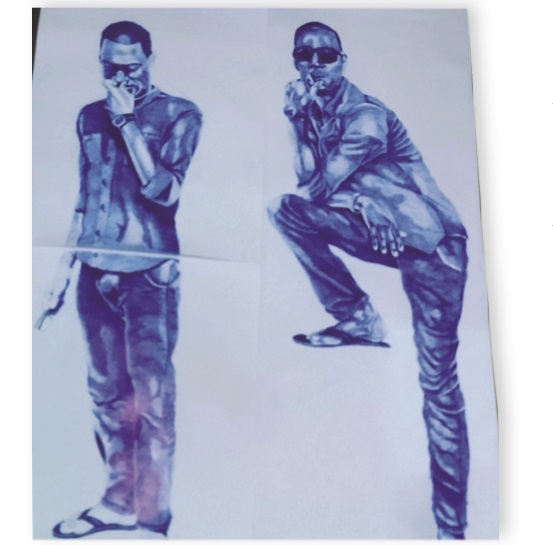
Some of the drawings are larger than life hanging on the white-washed walls of the large gallery space. At the entrance, a glass bottles installation hangs like a chandelier from the ceiling.
KAMPALA, UGANDA |DOMINIC MUWANGUZI| Inside the bottles are drawings of different facial expressions staring at you. Right beneath it, on soft boards and old newspapers, are similar drawings like those reflected inside the dangling glass bottles. The rather soft spoken artist, Leonard Opondo, says that he is inspired by daily emotions of people around him. “Portraits are more than external resemblance of what we observe. They’re a reflection of life’s journey about people,” he explains adding that he uses glass bottles to figuratively represent this contrast.
Right opposite, is a series of drawings titled `Who is your Saint’ by Adonias Ocom that interrogates the subject of sainthood and its validity in day to day life experiences. Ocom is influenced by social media to draw nubile women flaunting their sexuality as often happens in leaked sex tapes and videos that go viral on social platforms. The artist draws a halo on each of the “culprits” heads to paradoxically signify their saintly character.
Another artist, Adrian Miggade offers experimental drawings, `Soul inking’, using ink, wine, spirit and cotton buds on the same surface. He says it is inspired by his love for art and fashion magazines. According to the lanky artist, the technique involves him drawing the image on one side of canvas (paper) and marking out the positives and negatives with wine and spirits respectively. The result of such experimental process is a creation of a series of human figures that are both soulful and lovely. The soul aspect is echoed is the paper collage paintings produced from cut-outs from glossy old fashion magazines. The black and white images provide diverse textures for the painting while contributing to the narrative of recycling and integrating fashion designing into art.
A showcase of more experimental work is evident in the nude drawings by J.B Ssekubulwa and Andrew Arim that conjure the appreciation of the human figure and anatomy. The nude drawings are also interpreted as a figurative representation of the prevailing social landscape. In the context of the growing consumption of sexual material on social media, Arim’s futuristic drawings inspired by his love for science-fiction film lead to his imaginative creation of a series of drawing featuring a dominant high-tech human figure with a male lion’s head. The artist responds to themes like human evolution in the digital era, corruption and human exploitation, and Irene Piloya’s figurative drawings that entail the use of discarded hair weaves popular with many young women as fashion statement, against a background of polythene sacks.
The springboard to such creative innovation themed `Surfaces’, is an open call by the curator of the exhibit, Henry Mzili, to the featured artists to create art using drawing skills in a more experimental way. Emphasis in the exhibit is put on the application of the elements of art such as tone, line, and texture portrayed on formats that are larger than those they are used to while maintaining clarity, simplicity and variety throughout their creations.
With a showcase of such diverse styles and techniques, it can be argued that the youthful artists successfully yielded to the task; culminating into an artistic engagement between art, artist, and public. Additionally, the participation of young generation of artists in this exhibit does not only emphasise the fact that there is a lot of potential in the young breed of artists to create innovatively, but also provokes the already established artist to begin to work outside their comfort zones to tap into new audiences and spaces.
The exhibition opened on July 06 and will be open to only members of the gallery. Day pass for non-members is Shs20,000. Afriart on 7th is located on 7th Street opposite the Bread & Cake Shop.

****
 The Independent Uganda: You get the Truth we Pay the Price
The Independent Uganda: You get the Truth we Pay the Price



